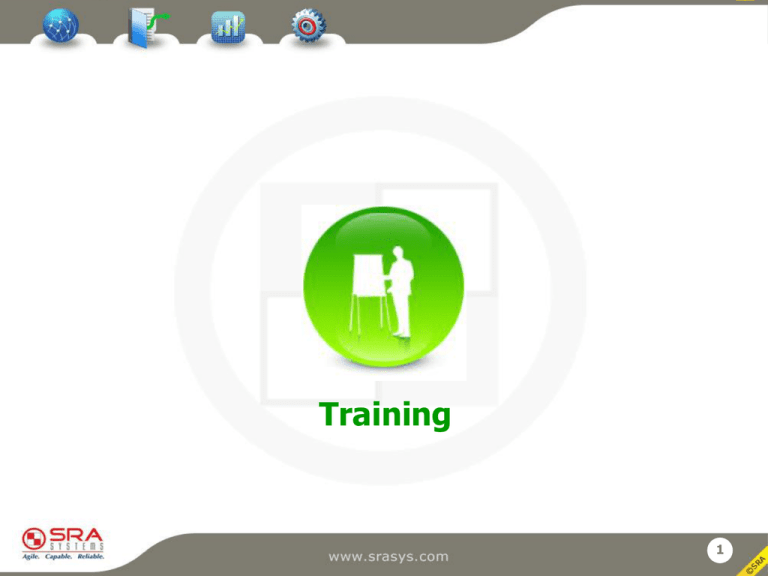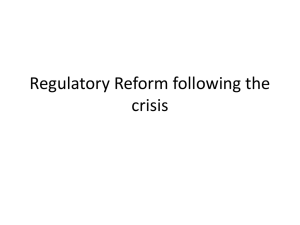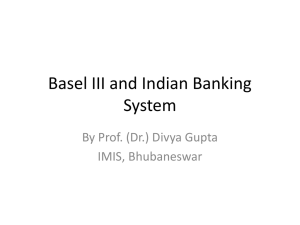training - SRA Systems
advertisement

Training 1 Training Banking Basel II QMS including Six Sigma ISMS 2 Banking Objective To provide basic understanding of Banking practices and operations Coverage Introduction to Banking Theory – Law & Practice Banking Overview – various types of Banks and operations Fundamentals of Accounting – Journal, Leger, Trial Balance, GL, Balance Sheet 3 Banking Introduction to different divisions in Banks Retail and Corporate Banking Payment Systems Trade Finance Treasury Delivery Channels – ATMs, Credit/ Debit cards, POS, etc. Merchant Banking – Demat, Mutual Funds, Investment Banking Compliance – AML, ALM, Basel II, etc. Target Audience General Bankers, technology groups Back 4 Basel II General Basel II – an awareness program Specific Market Risk Credit Risk Operational Risk 5 Basel II The Nature of risks and regulations in banking Evolution of risk management and regulations in banks Techniques in management - simple, intermediate and advanced Fundamentals of Market and Treasury Risk Management Fundamentals of Credit and Operational Risk Management Supervision and Regulation 6 Basel II Credit Risk The development of risk based supervision in banks Approaches for measurement and management Standardized approach of measurement and management Internal Ratings based approaches Mechanics & Parameters FIRB & AIRB Calibration & validation Usage tests 7 Basel II Market Risk Measurement and regulation Standardized approach of measurement and management Internal Models approach of measurement and management Nature of Treasury Risk Interest rate re-pricing in the banking book Methods of measuring and managing liquidity Capital Management and Treasury risk 8 Basel II Operational Risk Basic Indication approach to measuring Operational Risk Capital Standardized approach to measuring Operational Risk Capital Advanced measurement approach Managing Operational Risk Different frameworks and approaches Techniques used to mitigate operational risk Monitoring and reporting 9 Basel II Supervisory Review and its importance Internal Capital assessment process The four key principles and Specific issues Supervisory review of securitization, accountability and actions Role of National Supervisors Implementation issues Relationship between external/ internal auditors and supervisors 10 Basel II Supervision of Operational Risks and other risks Supervision of operational risks and electronic banking UK and US Supervision of operational risk Pillar 2 and other risks Bank Disclosure requirements Nature of disclosure, Basel II and disclosure Pillar 3 requirements, Scope of disclosure Risk exposure and assessment 11 Basel II Banking Technology Core Banking – is it the end? Payment systems across the globe Convergence of Banking and technology Risk Management and Regulatory Compliance 12 Basel II Target Audience CxO level – high level or overview and importance Senior Management – Credit, Market, Operations and Top Management Compliance Officers, Auditors, functional department officials Banking Technology Team Back 13 Quality Management System Objective To create the awareness amongst the associates/ employees To train identified associates/ employees on Quality Standard requirements To train on the Internal Audit – planning, conducting and follow-up 14 Quality Management System Coverage Introduction to Quality Management Different Quality Standards like ISO 9001:2000, CMMi different levels Process/ Product Quality concepts Different important Quality processes 15 Quality Management System Coverage Detailed training on QMS – Standard requirements separately for each standard Standard requirements Mapping the existing practices to standard Gap Analysis Processes – definition, revision, implementation strategies Monitoring Metrics 16 Quality Management System Coverage Internal Audit Objectives Code of ethics Audit Program/ Audit calendar Checklist development Audit techniques & Report preparation Follow-up methodology 17 Training – Quality Management System Target Audience All associates – for awareness session Quality team & Identified associates when organization is going in for fresh certification – for the detailed programs Internal Auditors/ associates identified for conducting audit internally – for Internal audit training program Back 18 Information Security Management System Coverage To create the awareness amongst the associates/ employees To train identified associates/ employees on ISO 27001 requirements To train on the Internal Audit – planning, conducting and follow-up 19 Information Security Management System Coverage Introduction to Information Security Information classification Risk Management Mitigation Controls Vulnerabilities and threats Information Security Management System (ISO 27001) Information Security policies like Password, Access Control etc 20 Information Security Management System Coverage Detailed training on ISMS – ISO 27001 Standard requirements Standard requirements Mapping the existing practices to standard Gap Analysis Processes – definition, revision, implementation strategies Monitoring Metrics 21 Information Security Management System Coverage Internal Audit Objectives Code of ethics Audit Program/ Audit calendar Checklist development Audit techniques & Report preparation Follow-up methodology 22 Information Security Management System Target Audience All associates – for awareness session Information Security team & Identified associates when organization is going in for fresh certification – for the detailed programs Internal Auditors/ associates identified for conducting audit internally – for Internal audit training program 23










